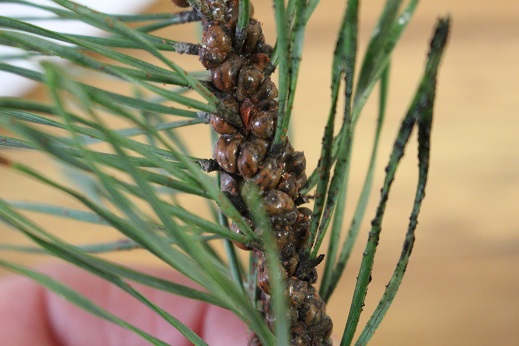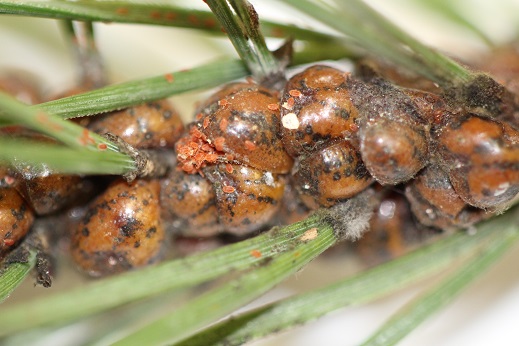— by Dr. Raymond Cloyd
It is time to be aware of the presence of pine tortoise scale, Toumeyella parvicornis, on pine trees. We have already received samples of pine tortoise scale with the crawlers (nymphs) emerging from the eggs. Pine tortoise scale feeds on many different types of pines, including: Scots, Austrian, and red. Immature females are round, brown, and wrinkled in appearance (Figure 1),
Fig 1. Pine tortoise scale on branch of pine tree (Author–Raymond Cloyd, KSU)
and overwinter on twigs (Figure 2).
Fig 2. Pine tortoise scale females on the twig of a pine tree (Author–Raymond Cloyd, KSU)
Eggs are laid underneath the body of adult females. In general, eggs hatch into red crawlers (nymphs) from May (RIGHT NOW) through June (Figure 3).
Fig 3. Pine tortoise scale crawlers emerging from eggs of females (Author–Raymond Cloyd, KSU)
The crawlers eventually find suitable locations and start feeding. Crawlers can spread to other pines via wind currents or by attaching to birds. Females can produce up to 500 crawlers within a generation. Males, like most scale species, develop into winged individuals that fly and mate with females. Males do not feed and eventually die. In Kansas, there is typically one generation of pine tortoise scale per year.
Pine tortoise scale feeding results in yellowing of needles, stunted needle growth, and under extensive populations can result in death of pines. Young pine trees, in general, are more susceptible to pine tortoise scale than older (mature) trees. In addition, foliage closer to the ground tends to support higher populations of pine tortoise scale than foliage higher in the tree canopy. Pine tortoise scale also produces copious amounts of honeydew, a clear sticky liquid that serves as a growing medium for black sooty mold. Entire pine trees may appear black from black sooty mold under heavy infestations of pine tortoise scale.
A forceful water spray applied twice per week will quickly dislodge/remove the crawlers and mature females from infested pine trees. Insecticides that are useful in suppressing populations of pine tortoise scale crawlers include: acephate (Orthene), acetamiprid (TriStar), bifenthrin (Talstar), cyfluthrin (Tempo), dinotefuran (Safari), imidacloprid (Merit), insecticidal soap (potassium salts of fatty acids), and horticultural oils (petroleum, mineral or neem-based). These insecticides must be applied when crawlers are active…which is RIGHT NOW…in order to obtain maximum suppression of pine tortoise scale populations and alleviate future problems.


